Table of contents
Let's roll up our sleeves and get our hands dirty with GraphQL schemas. Today, we're not just talking theory—we're diving into the practical side of things. Buckle up, because we're about to implement some GraphQL magic!
Define schema
Create a new file named "schema.ts" in the graphql directory. We will use this file for defining all the types for our graphql server.
Define the type "Post" which contains the following items
(a) id
(b) title
(c) contenttype Post { id: ID! # id of the post title: String! # title of the post content: String! # textual content of the post }Define the type "User" which contains the following items
(a) id(b) username
(c) email
(d) posts: this shows how the posts are related to the user
type User { id: ID! # id of the user username: String! # username of the user email: String! # email of the user posts: [Post] # posts written by the user }Define two query types for fetching user and posts
type Query { getUser(id: ID): User # query that will return user posts:[Post] # query that will return list of post }Combine all these types in graphql string and export them as a module
const typeDefs = `#graphql type Query { getUser(id: ID): User posts:[Post] } type User { id: ID! username: String! email: String! posts: [Post] } type Post { id: ID! title: String! content: String! } `; export default typeDefs;We can use this exported file in our graphql server instance
// importing typedefs aka schema import typeDefs from "./graphql/schema"; const server = new ApolloServer({ typeDefs, // using schema in our graphql server resolvers, });
Look at that! We're building a cozy space for users and their posts.
Pro Tip: Efficient schema relationships make your app perform like a champ.
You can view and fork the complete example on Github: Implementing graphql Schema
What's next?
In the next blog, we will implement the resolvers for the queries defined in the schema here, and try to understand how the post and user relationship works.
